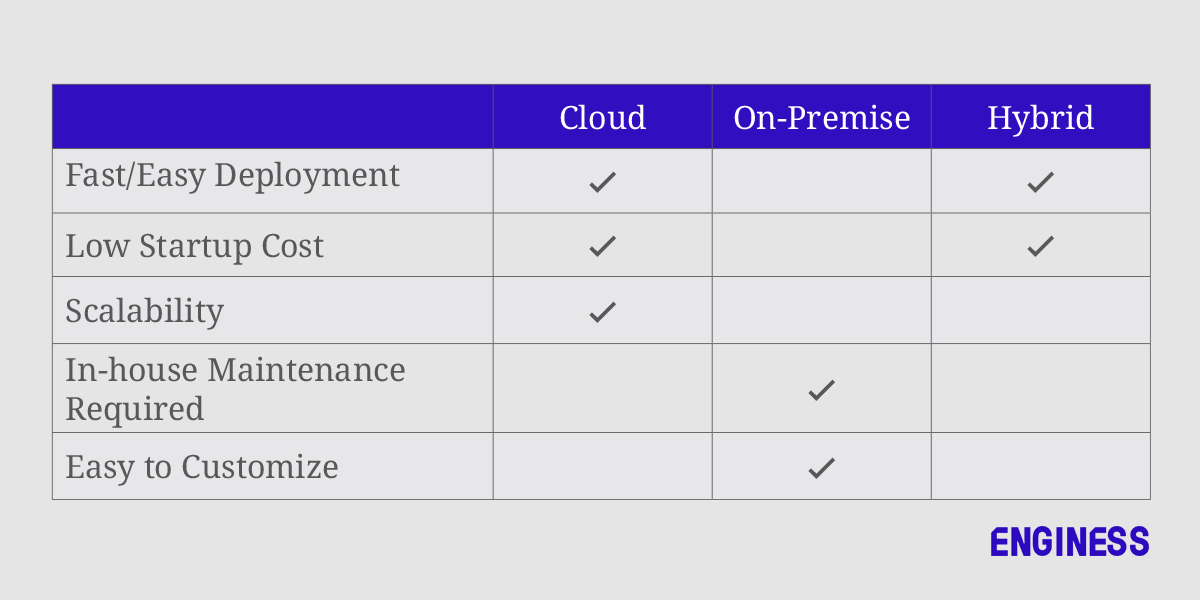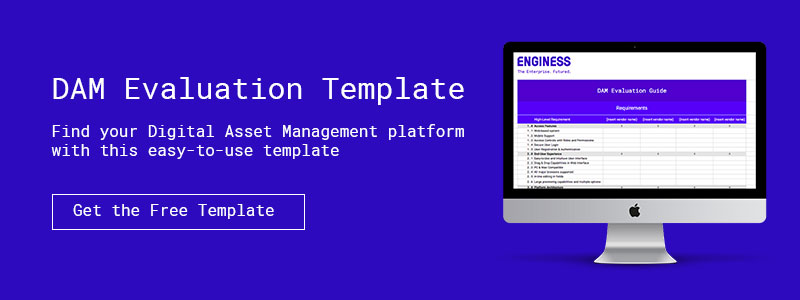For whatever reason, digital asset management systems remain off the table for many medium-sized enterprises.
But as our ability to store digital elements of our business and our awareness of the value of that content continues to grow, so does the demand for adequate DAM solutions. By 2022 the global DAM market is expected to be worth $5.66 billion, with a 18.3% CAGR.
In this post, we’re going to:
- Review the most important things to consider when you’re evaluating a DAM for your organization
- Compare common deployment methods
- 3 common to avoid when evaluating a DAM
- 4 vendors we think should be on your short list.
How to choose a DAM
As always, the first thing you need to do is clarify: what do you want your DAM to do? We’ve said it once and we’ll say it again — technology is a tool, not a solution. Your DAM deployment will only be effective if it’s the right tool for the job.
To help you understand what you’re looking for, ask yourself these questions:
What problem do I need to solve?
This isn’t a technical question, but a business or process question. What are you trying to change / what pain are you trying to address? Oftentimes, organizations skip this step, and they end up deploying technology that imperfectly solves their problem. As a first step, you need to identify what your pain points are.
What format are my digital assets in?
Next, clarify what digital assets you need to manage. Even mid-sized organizations might have multiple data silos for different things. Marketing, for instance, might have a repository of ads and collateral stored as videos, JPEGs, and more, whereas legal might have countless PDF documents and documents scans.
A clear understanding of what assets you're managing will give you a better idea of how to manage them.
Who are my DAM end-users?
You need to understand who your DAM solution is for, and the needs and demands of that end-user group.
First, it’s important for getting a product that’s fit for purpose. There’s no point in buying something that doesn’t actually solve the real problem where the rubber meets the road.

Second, your DAM is like a library — some people put stuff in, others take stuff out. You need to make sure you understand who is putting the stuff in (e.g. marketing teams) as well as who’s taking it out (e.g. sales reps).
Finally, failing to get end-users on board and excited about a digital project has scuppered many an implementation.
You need to confirm that you understand your end-users' pain and get a solution that works for them. Otherwise, your new DAM will languish, underused and unloved.
Make sure you know:
- Who’s uploading new documents to your DAM
- Who’s using assets from your DAM, and why
- How both these processes work now, and why
- What they like/don’t like about the current process.
Once you have a good idea of who is using it, what problem your DAM solves, and what format your assets will be in, it’s time figure out how you plan to deploy your DAM system.
Common DAM deployment methods
Deployment is the delivery mechanism for your DAM and really boils down to three options: cloud deployment, on-premise, or a hybrid of the two.
Each one has some pros and cons, so it’s more about finding one that works for your organization.
Cloud deployment
Cloud deployment is increasingly the deployment method of choice for medium-sized and enterprise organizations.
Cloud deployment includes a number of advantages, including low startup cost, rapid scaling, and (often) software-as-a-service (SaaS) business models that get companies up and running quickly.
However, cloud deployment is less secure, since most cloud DAM providers are hosting data in a multi-tenant public cloud (e.g. Amazon Web Services) which in theory may expose your organizations to additional vulnerabilities.
On-premise deployment
On-premise deployment, or on-prem, has been the method of choice for enterprise organizations since they started buying technology. It means that the server that assets are stored on is a local server, owned by the organization and managed by IT.
This presents challenges when it comes to things like computing elasticity, startup cost, scaling, and maintenance, all of which are easier to manage on a cloud deployment.
However, there are some perks.
First, despite the high capital cost, you own your asset rather than “renting” like you do under a cloud deployment.
Second, you completely control your system and can make it as closed or as open as you want.
And finally, on-premise solutions tend to be seen by the IT community as more secure because there are fewer vulnerabilities.
Hybrid solutions
Hybrid solutions are what they say on the tin — they’re a hybrid of on-premise and cloud solutions.
Hybrid DAMs can come in multiple formats, but generally, the software used to power the DAM is stored on the cloud to take advantage of things like rapid updating, elasticity, and access-anywhere functionality.
Then, the underlying data files are stored on-premise, safe and secure.
Hybrid solutions try and combine the best of both cloud and on-prem, and so have fewer strong pros or cons than the others. However, it’s worth noting that hybrid solutions are less common and, if it’s a requirement for your team, may restrict your vendor selection. They also tend to be expensive because you’re paying to maintain your on-prem instance as well as a subscription fee for the DAM software itself.
That said, for cloud-minded distributed teams handling highly-sensitive documents, hybrid deployment can be a happy medium.

3 DAM mistakes to avoid
1. Underestimating metadata
In the rush to consider big-picture strategy, deployment, function, and user experience, it’s easy to overlook metadata. Especially if you’re buying a DAM for the first time, you might not even think about metadata.
In reality, metadata is the most important part of your DAM. Every DAM should have some way to manage metadata, but each one does it in a specific way. Make sure the DAM you choose has a metadata structure that will work and grow with your organization.
2. Underestimating total cost of ownership (TCO)
Most DAMs will be priced on a storage or user basis, or some combination of both. But this is only part of your cost. Your full price also needs to include:
- Any custom configuration or ongoing training/support fees
- Implementation fees
- Custom integration / middleware extensions
- Maintenance fees (if you’ve opted for on-prem or hybrid solutions).
Altogether, this makes up your TCO. This should be the figure you look at when you’re evaluating different quotes.
3. Failing to consider collaboration features
The question is: do you want your DAM to be a repository or a key part of your content generation process?
We strongly recommend the latter. It means that collaborative thinking happens in the same place the asset is stored, keeping your documentation and tech stack streamlined and centralized. But often, collaboration features like permissions, commenting capabilities, alerts, and approval and release functionality is overlooked. Make sure you consider your collaboration needs early so you don’t abandon them by accident.

4 DAM vendors to consider
1. Bynder
Bynder is a DAM and, full disclosure, we’re an implementation partner. So we’re a little biased. Regardless, they’re one of the world’s best DAM system. They’re used by brands like KLM, TATA Steel, and Spotify. Generally speaking, Bynder works with larger enterprise organizations.
Benefits
- Customizable taxonomy
- Truly robust file format support
- Integrations into virtually any system you could want, including Salesforce, Adobe Creative Suite, ecommerce platforms, Sitefinity, and Templify.
Move on if...
Price is a sticking point. Additional modules can make the cost of Bynder jump significantly.
2. OpenText
OpenText is a Canadian giant in the world of enterprise software. Their core product is an enterprise information management (EIM), but they make a huge range of solutions at this point. Their DAM functionality is wrapped into a whole customer experience management platform.
Benefits
- Integrated solution unites your CMS, DAM, customer communication, forms, optimization software, and analytics all in one place.
- Dense functionality without engaging IT teams
- Particularly robust analytics on content and internal process performance, making it easy to identify bottlenecks / weak points.
Move on if...
You don’t need a whole solution and are really looking for a stripped-back DAM. While powerful, OpenText isn’t right for everyone.
3. Salsify
Salsify is a major DAM provider (among other solutions) for major brands like Coke, Bosch, and Fruit of the Looms. Their focus is on DAM for brands, so have plenty of technology built around working with agencies, global distribution, handling large assets, and generally helping you maintain a consistent brand no matter when your brand takes you.
Benefits
- Try before you buy feature — know exactly what you’re getting yourself into from the start
- Built specifically for ecommerce, sales, and marketing teams, so dense functionality in those areas
- Rapid implementation (60-90 days)
Move on if...
Your primary end-user lives outside sales and marketing. Salsify is (unsurprisingly) built for those audiences.
4. Wiredrive
Wiredrive is the top-ranked DAM on G2Crowd with a 4.3 rating across over 200 reviews. Their focus is on cataloguing and presenting digital assets so that teams can collaborate easily and building and sharing presentations a breeze.
Benefits
- Extremely collaborative
- Rapid file sharing across locations (even large files like videos)
- Built-in workflows
Move on if...
You core focus is internal rather than external-facing. Wiredrive pours significant resources into making presentations for clients that are easy to build, customize, and share.
Conclusion
A DAM can be a huge time-saver for both your digital asset production teams and your digital asset user ones. Whether you’re trying to drive collaboration and distribution of the latest and greatest or just trying to connect globally disconnected teams with the right collateral, a DAM can help.
But it’s a big purchase.
Make sure you do your due diligence for what you need your DAM to do, who you need it to serve, how you want to deploy it, and common mistakes to avoid.
And when it comes to vendor selection, these 4 can get you started, but make sure you do your own research. That’s why we put together this handy evaluation template to help you identify the right vendor for you.
Still, have questions about DAM solutions? Get in touch and see if we can help!
